Preliminary Risk Assessment of Geological Disasters in Qinglong Gorge Scenic Area of Taihang Mountain with GIS Based on Analytic Hierarchy Process and Logistic Regression Model
Abstract
:1. Introduction
2. Geological Environmental Overview and Data Source
2.1. Physical Geography and Geological Conditions
2.2. Data Sources
3. Development Characteristics and Influencing Factors of Geological Disasters
3.1. Development Characteristics of Geological Disasters in QGSA
3.2. Distribution Patterns of Geological Disasters in QGSA
3.3. The Return Period for Geological Disasters in QGSA
3.4. Influencing Factors of Geological Disasters in QGSA
3.4.1. Elevation
3.4.2. Slope Gradient
3.4.3. Stratum Lithologic
3.4.4. Distance from Fault
3.4.5. Rainfall
3.4.6. Human Engineering Activity
4. Geological Disaster Risk Assessment of QGSA
4.1. Hazard Assessment of Geological Disasters
4.1.1. Selection and Classification of Hazard Assessment Factors
- (1)
- Disaster density
- (2)
- Elevation
- (3)
- Slope
- (4)
- Lithology
- (5)
- Faults
- (6)
- Rainfall
- (7)
- Human engineering activities
4.1.2. The Determination of Logistic Regression Model and Assessment Factor Weight
4.1.3. Analysis and Test of Hazard Assessment Results
4.2. Vulnerability Analysis of Geological Disasters
4.2.1. Selection and Classification of Vulnerability Evaluation Factors
4.2.2. Determination of AHP and Evaluation Factor Weight
4.2.3. Vulnerability Evaluation Results
4.3. Risk Assessment of Geological Disasters
4.4. Countermeasures of Geological Disaster Prevention and Control in QGSA
5. Conclusions
- (1)
- Exploring the calculation methods of geological disaster risk elements, the applicability of these calculation methods is clarified.
- (2)
- By using the GIS platform, geological hazard risks and vulnerability assessment indicators for QGSA are proposed.
- (3)
- In light of the risk assessment results, a prevention and control system is proposed for high-risk areas, including monitoring and early warning, and engineering control of potential hazards.
- (4)
- The findings from this research paper suggest that numerical simulation methods can be employed for geological disaster risk assessments both before and after implementing the proposed prevention and control measures to validate their feasibility and effectiveness.
Author Contributions
Funding
Institutional Review Board Statement
Informed Consent Statement
Data Availability Statement
Conflicts of Interest
References
- Fell, R.; Hartford, D. Landslide risk management. In Landslide Risk Assessment; Cruden, D., Fell, R., Eds.; Routledge: London, UK, 2018; pp. 51–109. [Google Scholar]
- Zhang, S.; Tan, S.; Geng, H.; Li, R.; Sun, Y.; Li, J. Evaluation of Geological Hazard Risk in Yiliang County, Yunnan Province, Using Combined Assignment Method. Sustainability 2023, 15, 13978. [Google Scholar] [CrossRef]
- Einstein, H.H. Landslide Risk-systematic Approaches to Assessment and Management. In Landslide Risk Assessment; Cruden, D., Fell, R., Eds.; Balkema: Rotterdam, The Netherlands, 1997; pp. 25–50. [Google Scholar]
- UN-DRO. Natural Disasters and Vulnerability Analysis; Office of the United Nations Disaster Relief Co-Ordinator: New York, NY, USA, 1982. [Google Scholar]
- Zhang, S.; Tan, S.; Zhou, J.; Sun, Y.; Ding, D.; Li, J. Geological Disaster Susceptibility Evaluation of a Random-Forest-Weighted Deterministic Coefficient Model. Sustainability 2023, 15, 12691. [Google Scholar] [CrossRef]
- Varnes, D.J. Landslide Hazard Zonation: A Review of Principles and Practice; United Nations International: New York, NY, USA, 1984. [Google Scholar]
- Yang, H.; Wu, Q.; Dong, J.; Xie, F.; Zhang, Q. Landslide Risk Mapping Using the Weight-of-Evidence Method in the Datong Mining Area, Qinghai Province. Sustainability 2023, 15, 11330. [Google Scholar] [CrossRef]
- Blaikie, P.; Cannon, T.; Davis, I.; Wisner, B. Risk: Natural Hazards, People’s Vulnerability and Disasters; Routledge: London, UK, 1994; pp. 18–27. [Google Scholar]
- Shook, G. An assessment of disaster risk and its management in Thailand. Disaster 1997, 21, 77–88. [Google Scholar] [CrossRef] [PubMed]
- Zhang, L.; Zhang, Y.; Luo, Y. Theory and Practice of Geological Disaster Assessment; Geological Press: Beijing, China, 1998; pp. 20–45. [Google Scholar]
- Xiang, X.; Huang, R. Risk Assessment and Risk Management for Slope Geohazards. J. Geol. Hazards Environ. Preserv. 2000, 11, 38–41. [Google Scholar]
- Ma, Y.; Zhang, Y.; Zhang, C.; Wang, J. Theory and Approaches to the Risk Evaluation of Geological Hazards. J. Geomech. 2004, 10, 7–18. [Google Scholar]
- Morgenstern, N.R. Toward landslide risk assessment in practice. In Landslide Risk Assessment; Cruden, D.M., Fell, R., Eds.; Balkema: Rotterdam, The Netherlands, 1997; pp. 15–23. [Google Scholar]
- Jonkman, S.N.; van Gelder, P.H.; Vrijling, J.K. An overview of quantitative risk measures for loss of life and economic damage. J. Hazard. Mater. 2003, 99, 1. [Google Scholar] [CrossRef] [PubMed]
- Westen, C.J.V.; Asch, T.W.J.V.; Soeters, R. Landslide hazard and risk zonation—Why is it still so difficult? Bull. Eng. Geol. Environ. 2006, 65, 167–184. [Google Scholar] [CrossRef]
- Murgese, D.; Fontan, D.; Pirulli, M.; Scavia, C.; Oria, P. Debris-Flow Risk Assessment and Land Management at Municipal Scale. In Landslide Science and Practice; Springer: Berlin/Heidelberg, Germany, 2013; pp. 391–397. [Google Scholar]
- Wu, S.R.; Shi, J.S.; Zhang, C.S.; Wang, T. Preliminary discussion on technical guideline for geohazard risk assessment. Geol. Bull. China 2009, 28, 995–1005. [Google Scholar]
- Zhang, M. Geological Hazard of Landslide Collapse in Baota District, Yan’an; Geological Press: Beijing, China, 2008. [Google Scholar]
- He, Y.; Pei, X.; Liang, J.; Gu, H. Risk assessment and range prediction of dangerous rockmass based on rockfall: A case study of the Xuangou Collapse. Chin. J. Geol. Hazard Control 2020, 31, 24–33. [Google Scholar]
- Han, Y.; Cui, P.; Liu, H.; Yanf, M.; Li, Z. Study on Risk Assessment Methodology of Debris-flow Disasters and Its Application. China Saf. Sci. J. 2008, 18, 140–147+26. [Google Scholar]
- Ye, X. Research on Natural Disasters Risk Assessment of Tourist Destination. Ph.D. Thesis, Shanghai Normal University, Shanghai, China, 2011. [Google Scholar]
- Zhou, L. Study on the Tourism Risk Evaluation and Management of the Mountain Scenic. Ph.D. Thesis, Northeast Normal University, Changchun, China, 2012. [Google Scholar]
- He, J.; Guo, Y.; Zhang, M.; Ma, M.; Xiong, W.; Yang, H.; Li, Y. Fuzzy Comprehensive Evaluation of Tourism Safety Risk in Mountain Scenic Areas. Sichuan Environ. 2019, 38, 101–107. [Google Scholar]
- Nilsen, T.H.; Brabb, E.E. 18 slope-stability studies in the San Francisco Bay Region, California. Rev. Eng. Geol. 1977, 3, 233–244. [Google Scholar]
- Lyu, H.-M.; Shen, J.S.; Arulrajah, A. Assessment of Geohazards and Preventative Countermeasures Using AHP Incorporated with GIS in Lanzhou, China. Sustainability 2018, 10, 304. [Google Scholar] [CrossRef]
- Peduzzi, P.; Dao, H.; Herold, C.; Mouton, F. Assessing global exposure and vulnerability towards natural hazards: The Disaster Risk Index. Nat. Hazards Earth Syst. Sci. 2009, 9, 1149–1159. [Google Scholar] [CrossRef]
- Sun, Y.; Chen, P. Research on Disaster Risk Evaluation Model for Regional Tourism Resources. J. Chang. Norm. Univ. (Nat. Sci. Ed.) 2010, 29, 83–85. [Google Scholar]
- Anbalagan, R.; Singh, B. Landslide hazard and risk assessment mapping of mountainous terrains-a case study from kumaun Himalaya, India. Eng. Geol. 1996, 43, 237–246. [Google Scholar] [CrossRef]
- Pei, H.; Chen, J.; Li, W.; Chewn, W. Geological Disaster Risk Assessment in Gansu Province. J. Catastrophology 2017, 32, 97–102. [Google Scholar]
- Ruan, S.; Huang, R. Application of GIS-based Information Model on Assessment of Geological Hazard Risk. J. Chengdu Univ. Technol. 2001, 28, 89–92. [Google Scholar]
- Ni, X.; Nan, Y. Comprehensive assessment of geological disaster risk in Changbai Mountain region based on GIS. J. Nat. Disasters 2014, 23, 112–120. [Google Scholar]
- Zhu, L.; Yin, K.; Zhang, L.; Li, M. Risk Analysis System of Geo-hazards Supported by GIS. J. Yangtze River Sci. Res. Inst. 2002, 19, 42–44. [Google Scholar]
- Sun, Y.; Yang, Q.; Chen, P. Dynamic Evaluation of Tourism Safety Risk in the Changbai Mountains Scenic Spot. Sci. Geogr. Sin. 2019, 39, 770–778. [Google Scholar]
- Luo, L.; Pei, X.; Gu, H.; He, Y.; Liang, J. Risk assessment of geohazards induced by “8.8” earthquake based on GIS in Jiuzhaigou scenic area. J. Nat. Disasters 2020, 29, 193–202. [Google Scholar]
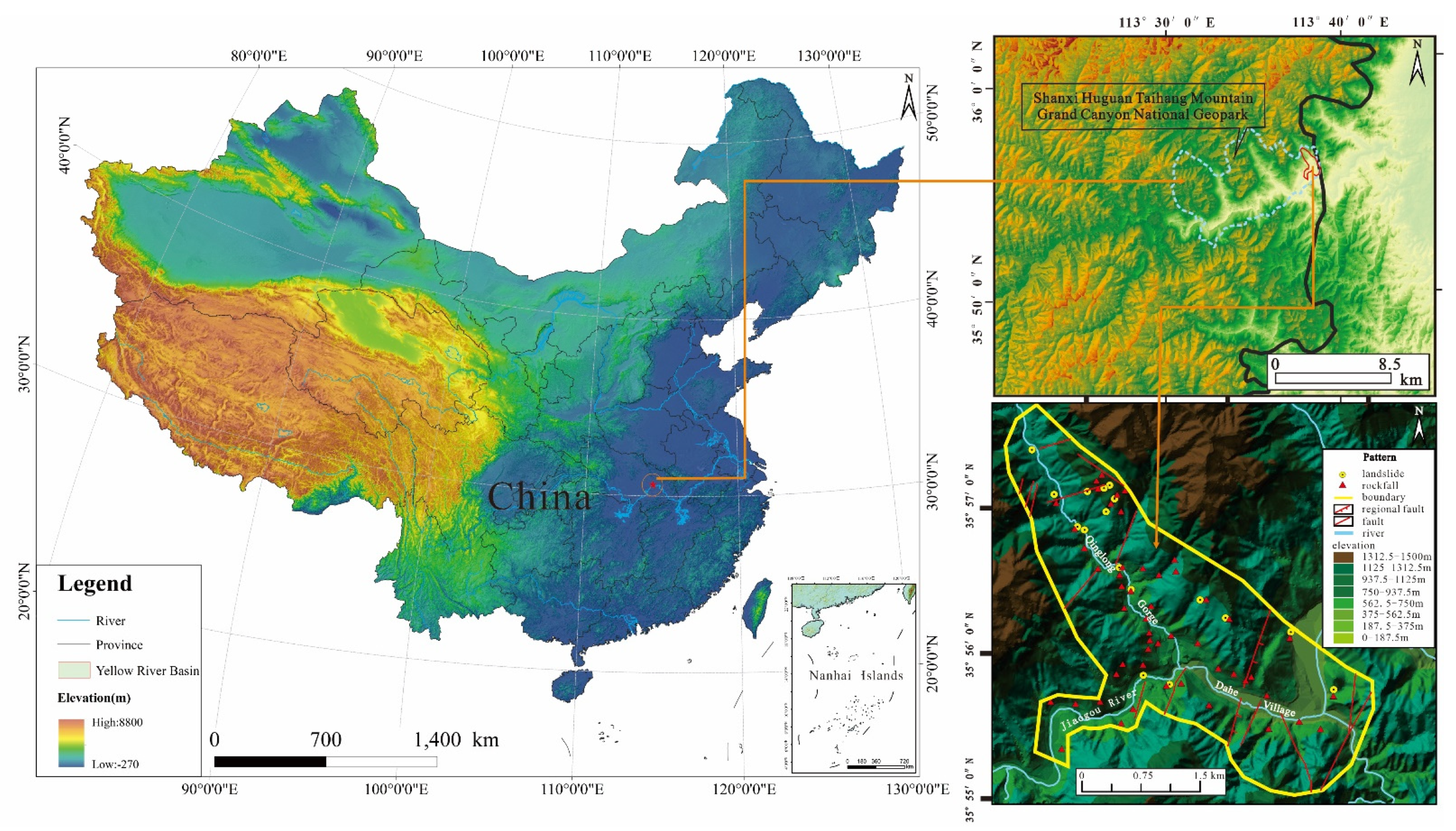

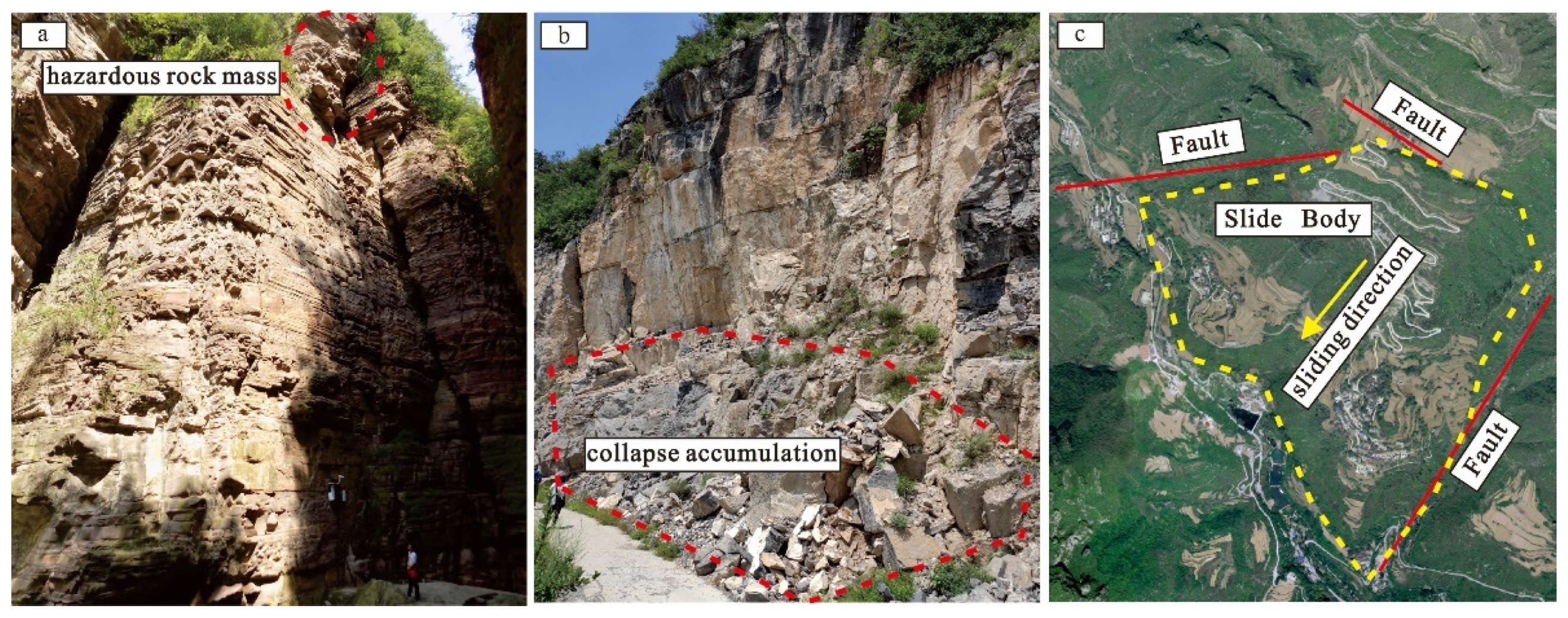
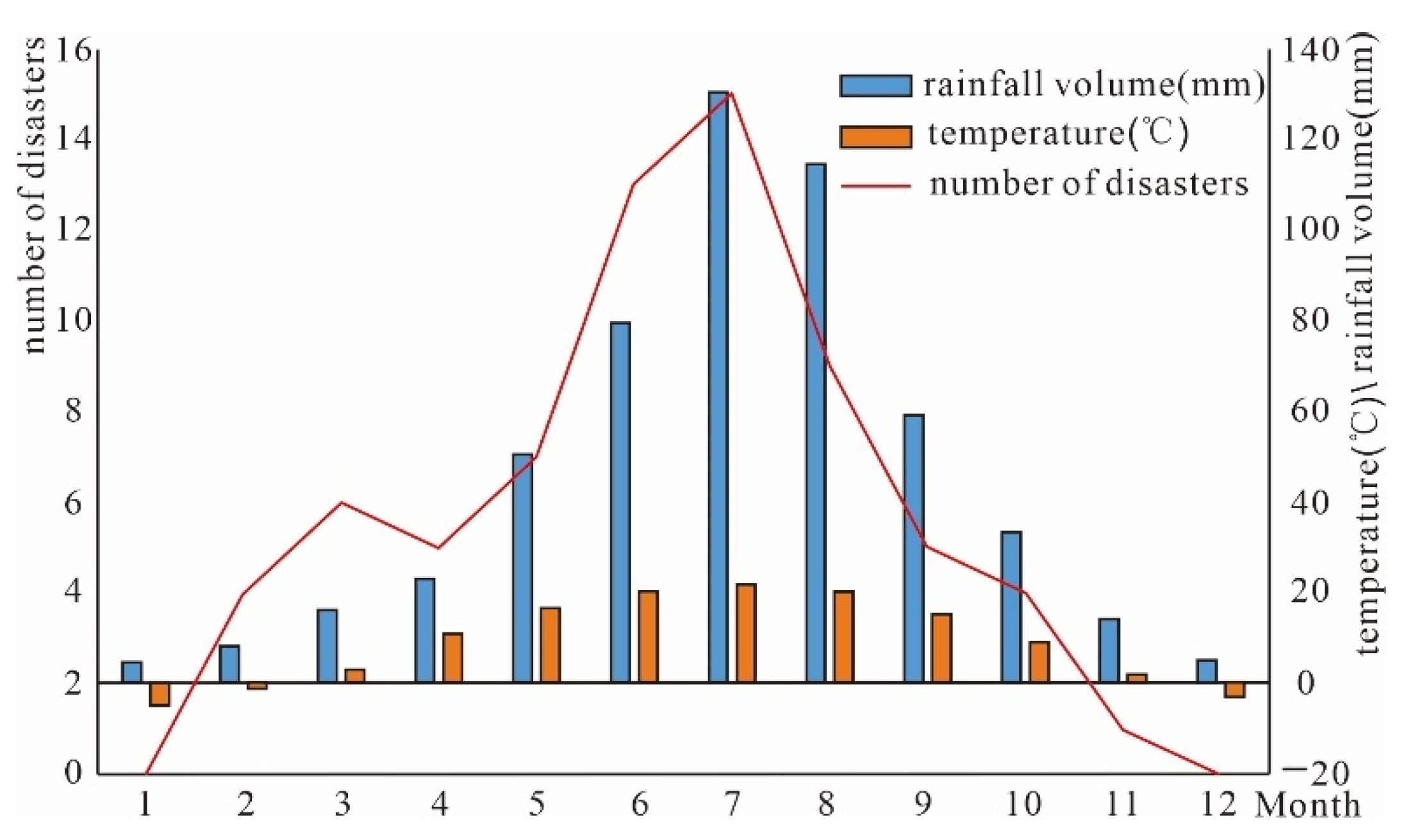
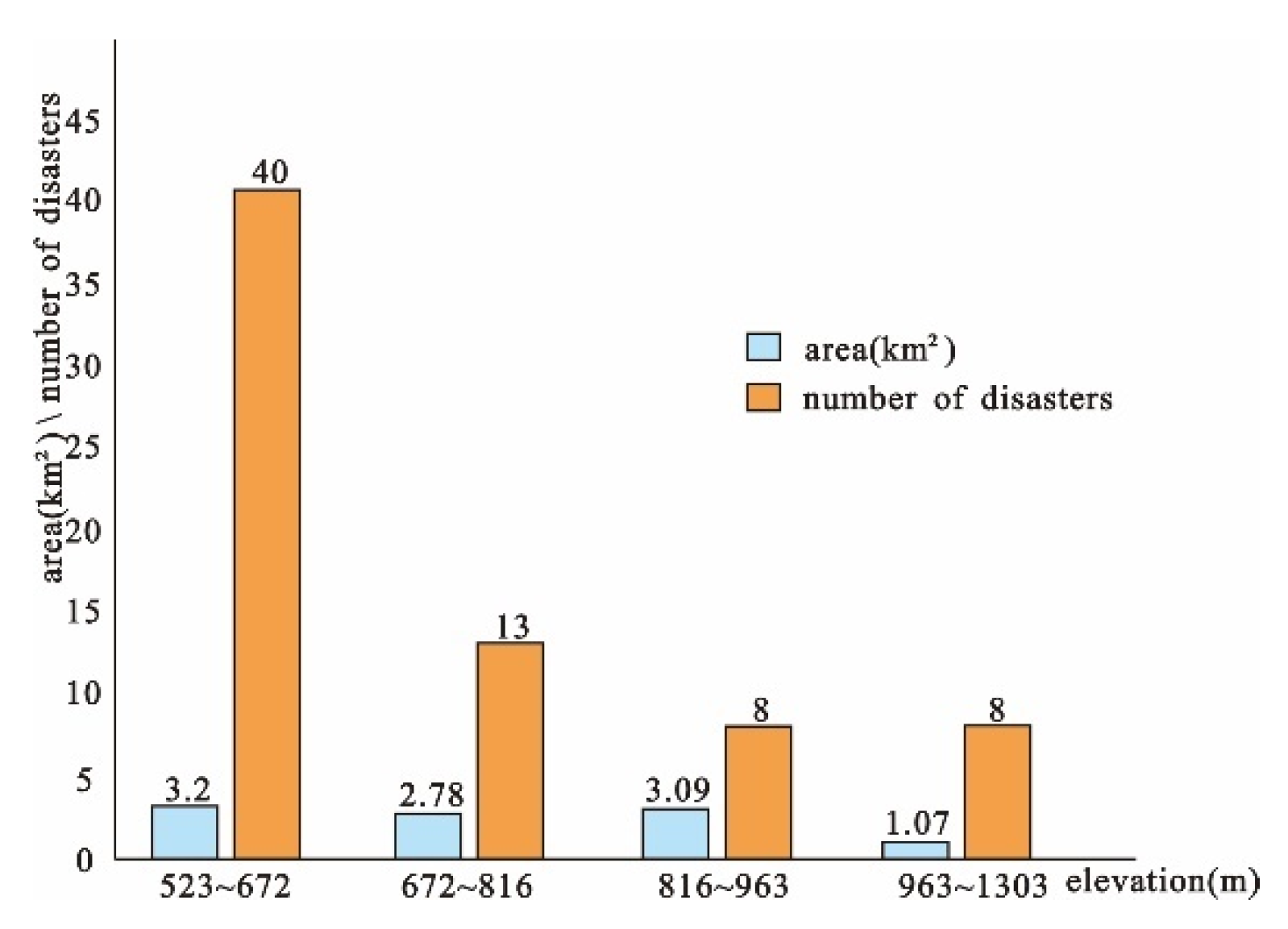
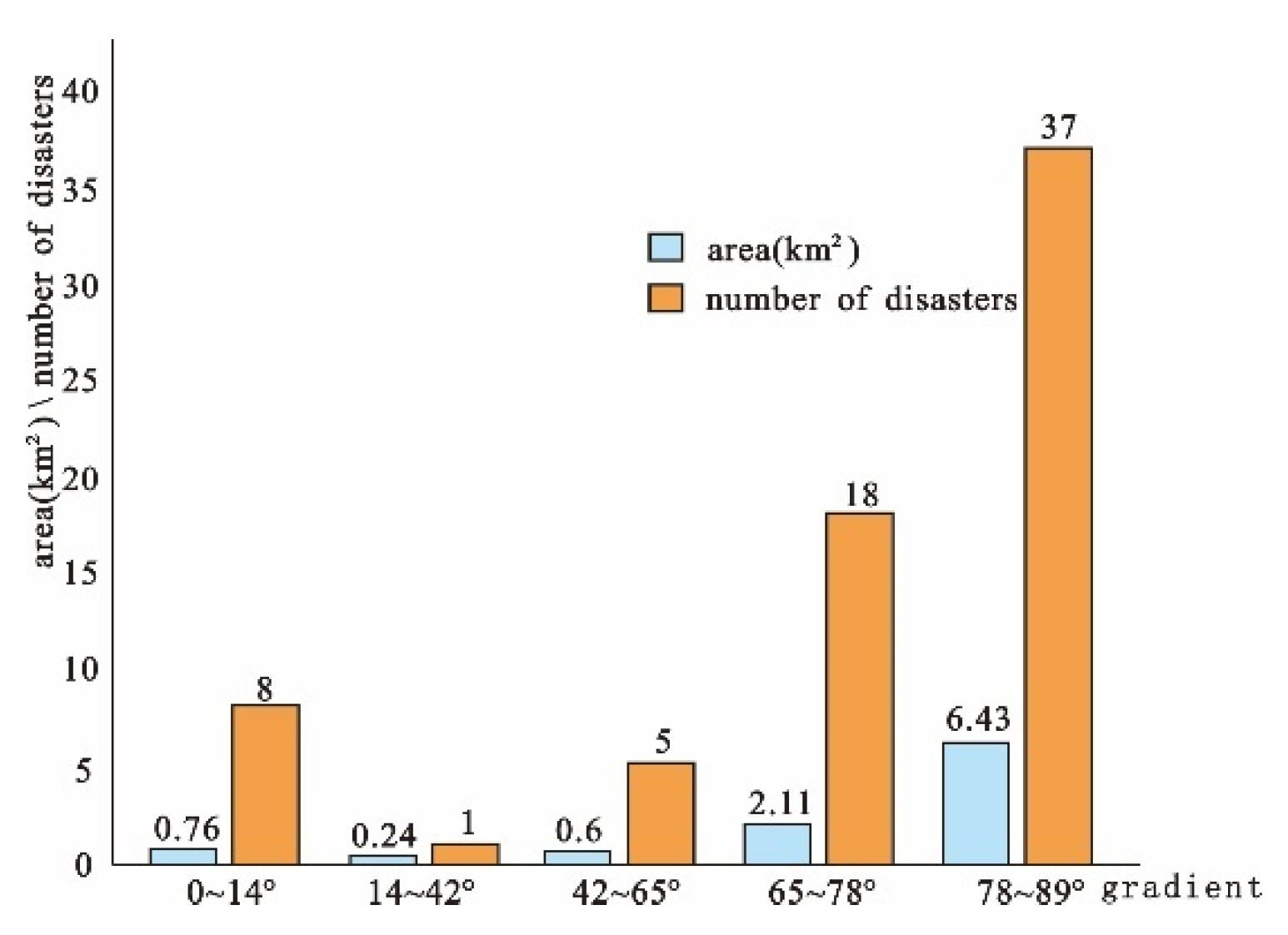
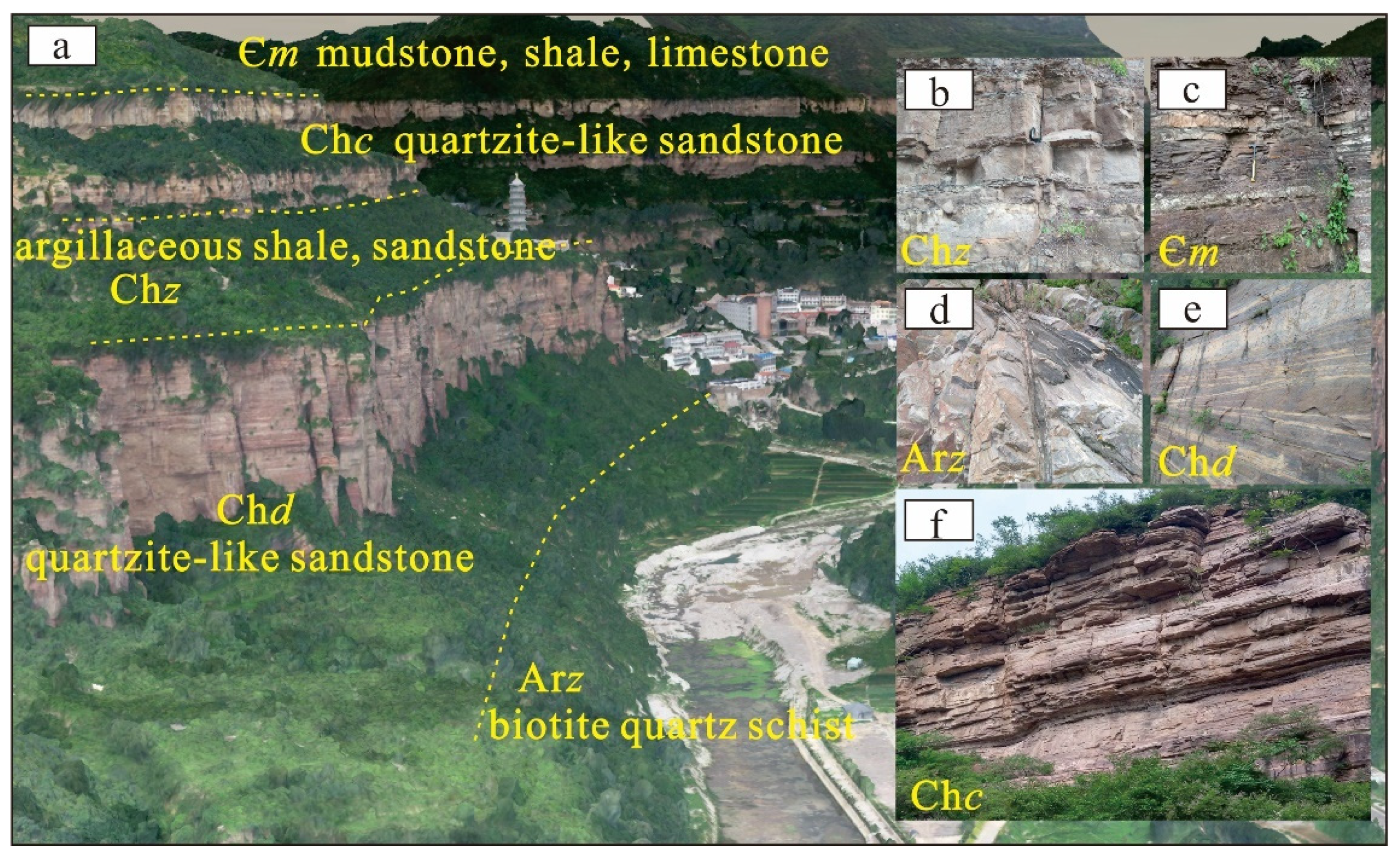
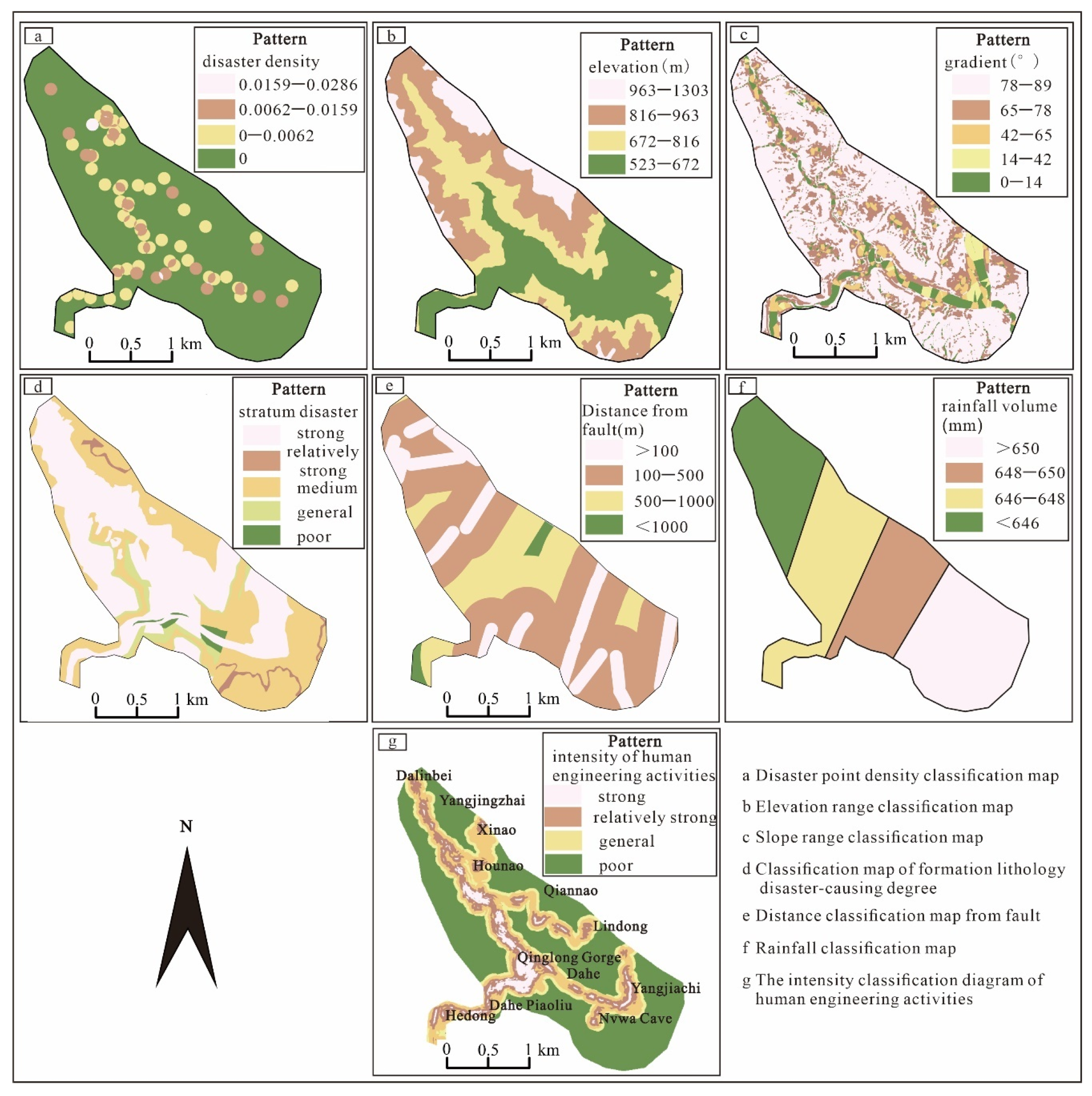
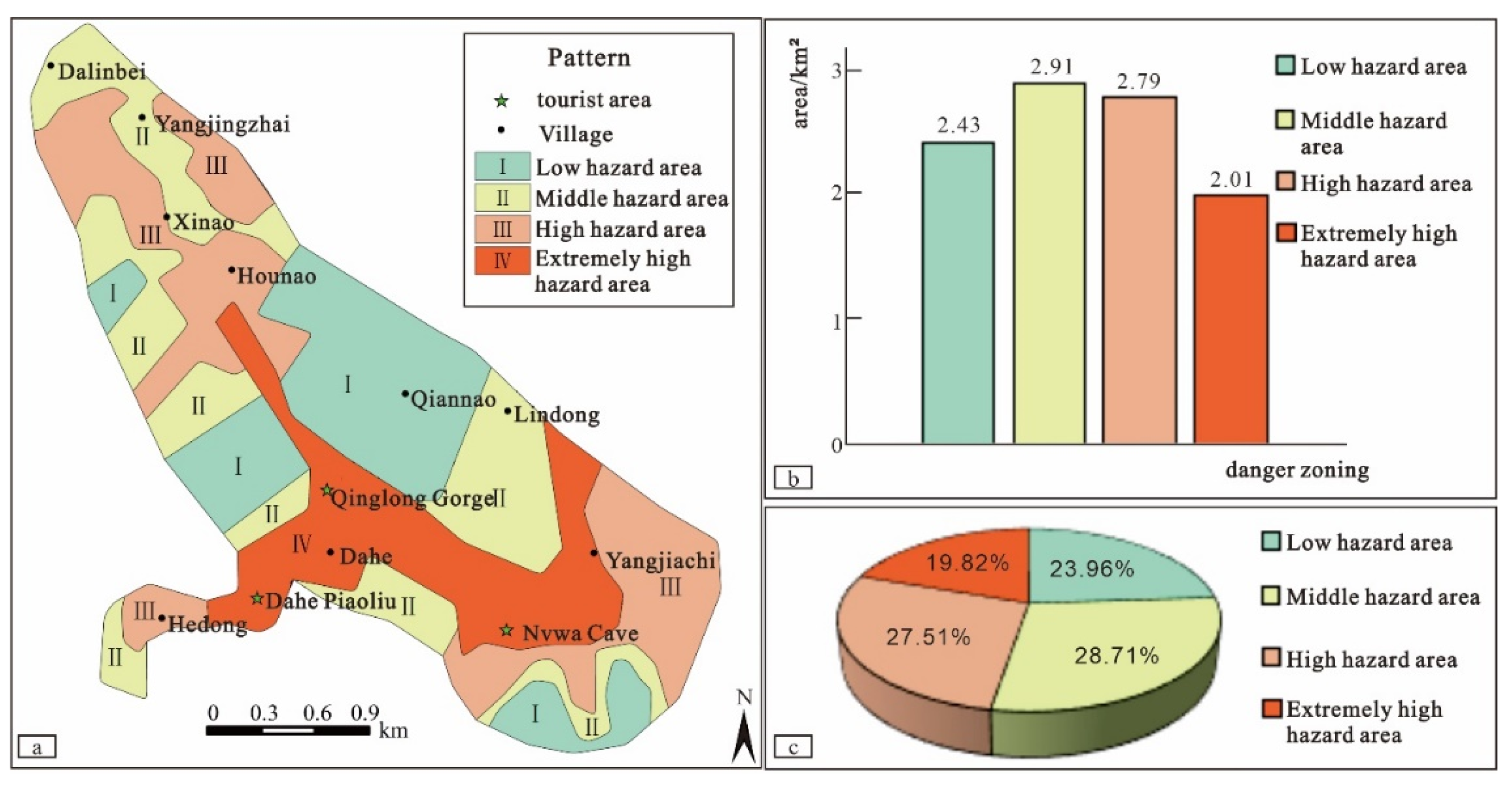

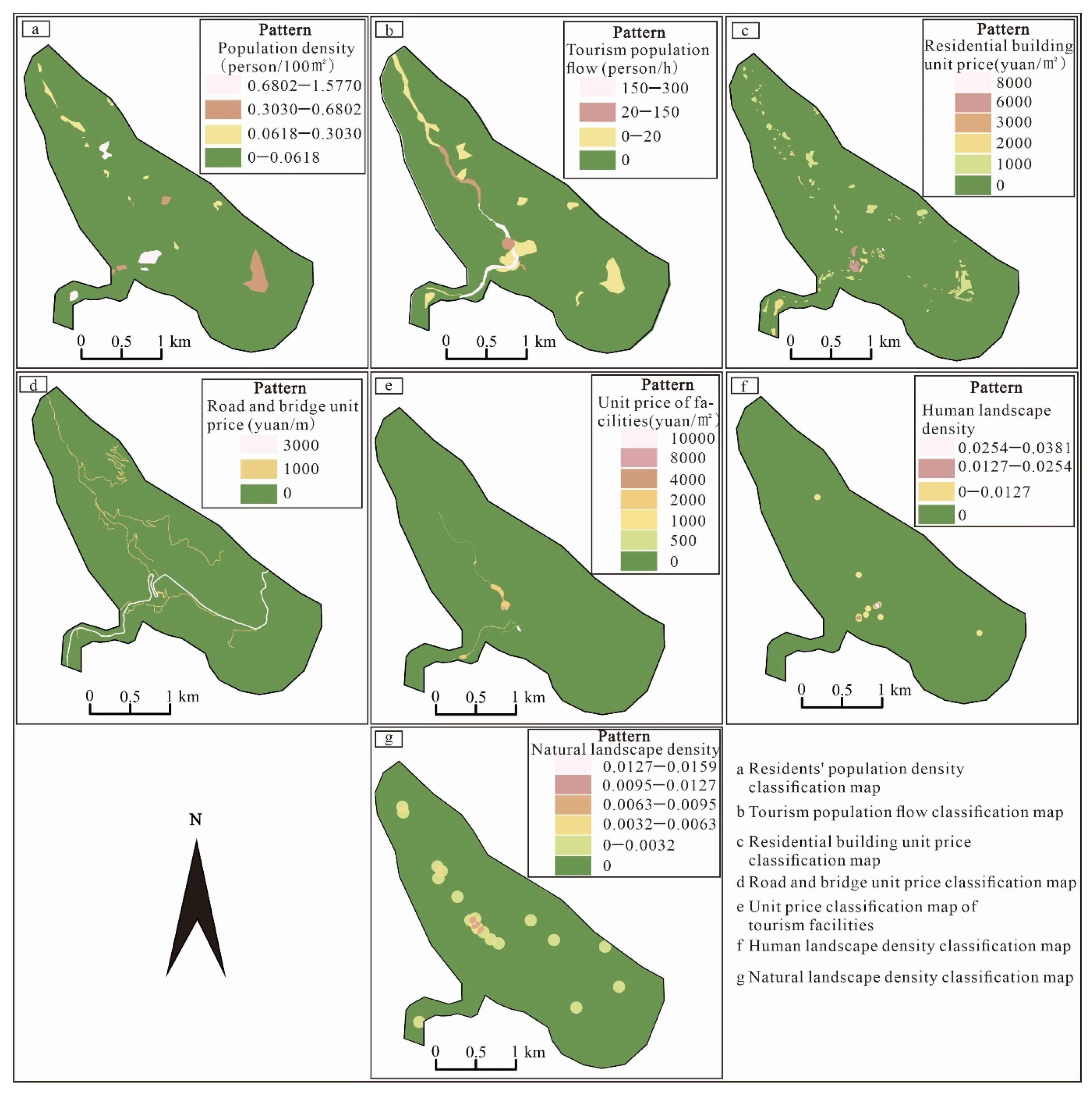

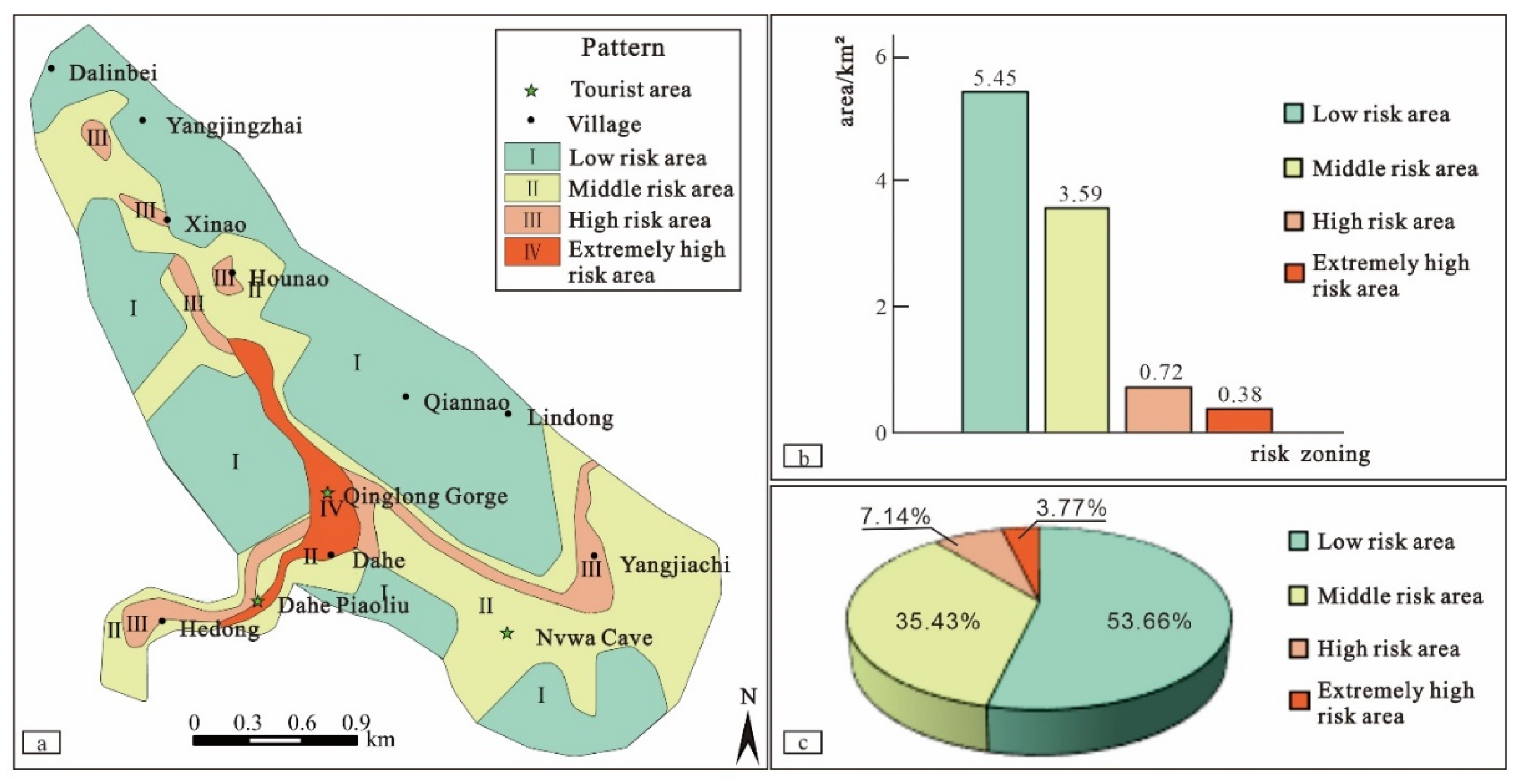
| Evaluation Factor | Stratum Lithologic | Distance from Fault | Elevation | Slope Gradient | Human Engineering Activity | Geohazard Density | Rainfall |
|---|---|---|---|---|---|---|---|
| Regression coefficient | 1.468 | 1.526 | −1.126 | −0.901 | 1.417 | 1.295 | −0.842 |
| Significance | 0.000 | 0.000 | 0.000 | 0.000 | 0.000 | 0.010 | 0.025 |
| Weight | 0.1712 | 0.1780 | 0.1313 | 0.1051 | 0.1652 | 0.1510 | 0.0982 |
| Criterion Layer | Population Vulnerability | Material Vulnerability | Vulnerability of Tourism Resources | ||||
|---|---|---|---|---|---|---|---|
| Schematic Layer | Resident Population | Tourism Population | Tourist Facilities | Residential Structure | Road, Bridge | Cultural Landscape | Natural Landscape |
| Scheme layer weight | 0.25 | 0.75 | 0.2970 | 0.1634 | 0.5936 | 0.25 | 0.75 |
| Consistency test of scheme layer weight | = 0 | = 0.0088 | = 0 | ||||
| Criterion layer weight | 0.7778 | 0.1111 | 0.1111 | ||||
| Criterion layer weight consistency test | 0 | ||||||
| Index weight | 0.1944 | 0.5833 | 0.0330 | 0.0182 | 0.0600 | 0.0278 | 0.0833 |
Disclaimer/Publisher’s Note: The statements, opinions and data contained in all publications are solely those of the individual author(s) and contributor(s) and not of MDPI and/or the editor(s). MDPI and/or the editor(s) disclaim responsibility for any injury to people or property resulting from any ideas, methods, instructions or products referred to in the content. |
© 2023 by the authors. Licensee MDPI, Basel, Switzerland. This article is an open access article distributed under the terms and conditions of the Creative Commons Attribution (CC BY) license (https://creativecommons.org/licenses/by/4.0/).
Share and Cite
Ma, R.; Lyu, Y.; Chen, T.; Zhang, Q. Preliminary Risk Assessment of Geological Disasters in Qinglong Gorge Scenic Area of Taihang Mountain with GIS Based on Analytic Hierarchy Process and Logistic Regression Model. Sustainability 2023, 15, 15752. https://doi.org/10.3390/su152215752
Ma R, Lyu Y, Chen T, Zhang Q. Preliminary Risk Assessment of Geological Disasters in Qinglong Gorge Scenic Area of Taihang Mountain with GIS Based on Analytic Hierarchy Process and Logistic Regression Model. Sustainability. 2023; 15(22):15752. https://doi.org/10.3390/su152215752
Chicago/Turabian StyleMa, Ruixia, Yan Lyu, Tianbao Chen, and Qian Zhang. 2023. "Preliminary Risk Assessment of Geological Disasters in Qinglong Gorge Scenic Area of Taihang Mountain with GIS Based on Analytic Hierarchy Process and Logistic Regression Model" Sustainability 15, no. 22: 15752. https://doi.org/10.3390/su152215752
APA StyleMa, R., Lyu, Y., Chen, T., & Zhang, Q. (2023). Preliminary Risk Assessment of Geological Disasters in Qinglong Gorge Scenic Area of Taihang Mountain with GIS Based on Analytic Hierarchy Process and Logistic Regression Model. Sustainability, 15(22), 15752. https://doi.org/10.3390/su152215752







